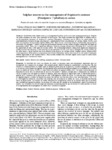Use este identificador para citar ou linkar para este item:
http://www.alice.cnptia.embrapa.br/alice/handle/doc/1002472Registro completo de metadados
| Campo DC | Valor | Idioma |
|---|---|---|
| dc.contributor.author | NASCIMENTO, V. L. do | pt_BR |
| dc.contributor.author | MIRANDA, J. E. | pt_BR |
| dc.contributor.author | MALAQUIAS, J. B. | pt_BR |
| dc.contributor.author | CARVALHO, M. da C. S. | pt_BR |
| dc.contributor.author | LINS, L. C. P. | pt_BR |
| dc.contributor.author | PANIAGO, J. | pt_BR |
| dc.date.accessioned | 2014-12-15T11:11:11Z | pt_BR |
| dc.date.available | 2014-12-15T11:11:11Z | pt_BR |
| dc.date.created | 2014-12-15 | pt_BR |
| dc.date.issued | 2014 | pt_BR |
| dc.identifier.citation | Revista Colombiana de Entomologia, Bogotá, v. 40, n. 1, p. 15-20, jan./june 2014. | pt_BR |
| dc.identifier.uri | http://www.alice.cnptia.embrapa.br/alice/handle/doc/1002472 | pt_BR |
| dc.description | Soil fertility with sulphur sources is an important tool that can be used in the management of pests. Sulphur can induce tolerance or even cause mortality to insect pests. This study evaluated the application of sulphur sources on the population dynamics of Scaptocoris castanea (Hemiptera: Cydnidae) and its effects on cotton plants. The experiment had a factorial design consisting of a combination of four concentrations of calcium sulfate (CaSO4) and four concentrations of ammonium sulphate [(NH4)2SO4]. There was no correlation between soil humidity (%) and insect infestation (%) (nymphs + adults), except for the treatment without calcium sulfate (0 kg/ha) along with 208 kg/ha of ammonium sulfate. There was a significant difference between average and previous infestation of S. castanea with the application of only 1,500 kg/ha of calcium sulfate. The relationship between cotton yield (kg/ha) and ammonium sulfate was best described by a cubic function at concentrations of 750, 1,125 and 1,500 kg/ha of calcium sulfate; on the other hand, a linear function was best adjusted in the absence of calcium sulfate. Sulphur sources influenced the visual appearance of the plants as many plants were found with injuries and/or were reduced in size in those treatments without application of any sulphur sources. These results reinforce the idea that suphur sources may be useful in the management of S. castanea on cotton. | pt_BR |
| dc.language.iso | eng | eng |
| dc.rights | openAccess | eng |
| dc.title | Sulphur sources on the management of Scaptocoris castanea (Hemiptera: Cydnidae) on cotton. | pt_BR |
| dc.type | Artigo de periódico | pt_BR |
| dc.date.updated | 2014-12-15T11:11:11Z | pt_BR |
| dc.subject.thesagro | Algodão | pt_BR |
| dc.subject.thesagro | Sulfato de amônia | pt_BR |
| dc.subject.thesagro | Sulfato de cálcio | pt_BR |
| dc.subject.thesagro | Percevejo | pt_BR |
| dc.subject.thesagro | Scaptocoris castanea | pt_BR |
| riaa.ainfo.id | 1002472 | pt_BR |
| riaa.ainfo.lastupdate | 2014-12-15 | pt_BR |
| dc.contributor.institution | VANIA LUCIA DO NASCIMENTO, FUNDAÇÃO DE APOIO A PESQUISA E DESENVOLVIMENTO DE GOIÁS; JOSE EDNILSON MIRANDA, CNPA; JOSE BRUNO MALAQUIAS, CNPA; MARIA DA CONCEICAO SANTANA CARVALHO, CNPAF; LUIS CARLOS PINHEIRO LINS, mestrando UFG; JULIMAR PANIAGO, FUNDAÇÃO DE APOIO A PESQUISA E DESENVOLVIMENTO DE GOIÁS. | pt_BR |
| Aparece nas coleções: | Artigo em periódico indexado (CNPAF)  | |
Arquivos associados a este item:
| Arquivo | Descrição | Tamanho | Formato | |
|---|---|---|---|---|
| mcsc.pdf | 5,74 MB | Adobe PDF |  Visualizar/Abrir |









